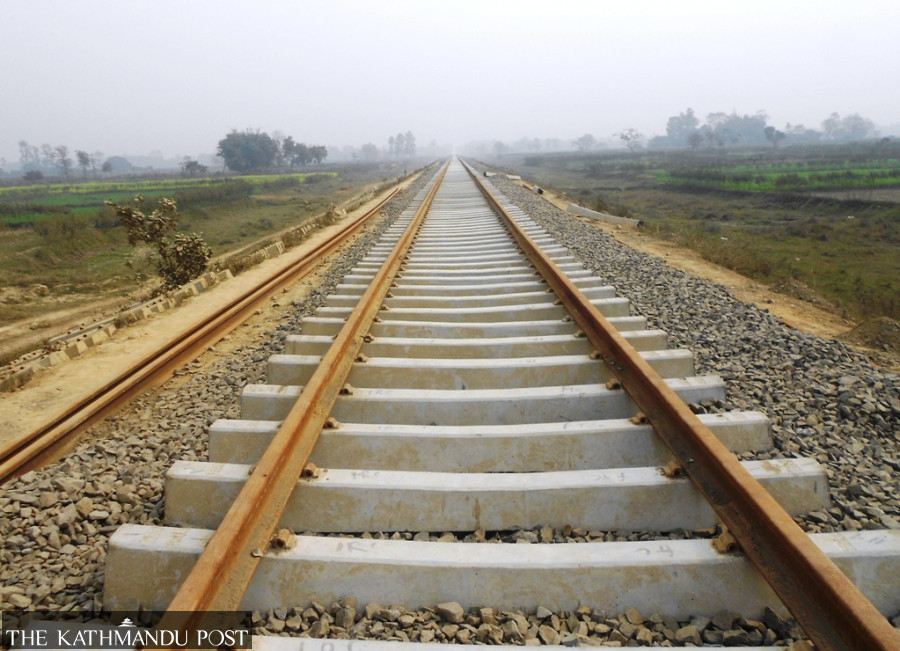Money
Kurtha-Jayanagar railroad to have fewer level crossings
The move is aimed at reducing train-vehicle collisions.
Prithvi Man Shrestha
The government is planning to reduce the number of road and railroad intersections along the Kurtha-Jayanagar Railway line to reduce the possibility of accidents.
As the government prepares to operate the railway service on the 34.9km long railway line connecting Kurtha of Nepal and Indian border town of Jayanagar, it has emerged there are many level crossings and this could be risky.
“As suggested by the consultant, we are looking at ways to reduce such crossings,” said Keshav Kumar Sharma, joint secretary at the Ministry of Physical Infrastructure and Transport. “Since it is a cross-border railway line, the Indian government is also in favour of reducing the number of level crossings.”
According to the Department of Railways, there are about two dozen level crossings along the nearly 35km railroad on the Nepali side.
“There are 4-5 crossings within the city of Janakpur alone,” said Deepak Kumar Bhattarai, director general of the department.
Without a proper system of signs and signals in place, officials say there might be train-vehicle collisions at the crossings. “The Indian side has suggested that we reduce such crossings substantially. We will study the situation in the field and make a necessary decision on how we can reduce their numbers,” said Bhattarai.
Officials, however, said that while reducing the number of such crossings, they would also see whether it would affect public mobility. “Railway staff should be stationed at such crossings to stop road vehicles when a train is approaching,” said Sharma.
This has emerged as an important issue to address the safety of passengers even though the government still has a long way to go to resume the railway service after a gap of nearly eight years.
Even though two sets of Diesel Electric Multiple Unit trains arrived in the country with much fanfare in September last year, they are yet to come into operation due to delays in fulfilling a number of prerequisites. The rail sets have remained stranded in Janakpur for more than a year.
At least two roadblocks to the operation of the railway have been removed with Nepal and India signing a standard operating procedure in early October and India handing over the Kurtha-Jayanagar section of the railway infrastructure to Nepal on October 22.
But, there is currently no law and human resources for operating the railway service.
In fact, there was a law in the form of an ordinance introduced by then KP Sharma Oli-led government on May 5.
Although the current Sher Bahadur Deuba-led government tabled the ordinance on July 18 in parliament, it became invalid after the government failed to get a parliamentary nod within 60 days (by September 16) of its tabling in the House. Likewise, the Nepal Railway Company last month fired over 150 staff hired by the previous government, leaving the company virtually staffless.
Sharma said that the government was preparing to introduce an ordinance to operate the railway. “The content of the ordinance will be almost the same as the last ordinance,” he said. “Our legal department is working on a draft before sending it to the cabinet.”
He also said that the ministry has already instructed the Nepal Railway Company to recruit staff on temporary contracts to resume the operation of the railway at the earliest. Several attempts by the Post to contact Niranjan Jha, the general manager of the company, were unsuccessful.
With the government yet to promulgate an ordinance and the Nepal Railway Company yet to start the process for hiring staff, it is not certain when the train service will come into operation.
“Our hope is that we may be able to start the railway service by the end of 2021,” Sharma told the Post late last month.
When it comes into operation, it will be the country’s first broad gauge railway service. Earlier, there was a slow-moving narrow gauge railroad from Janakpur to Jayanagar that had served people from 1937 to January 2014. The railroad was first laid as a cargo line to carry timber from Nepal to India. After dismantling the narrow gauge track, a new broad gauge railroad was laid with the assistance of the Indian government. The work was completed in late 2019.




 7.12°C Kathmandu
7.12°C Kathmandu













%20(1).jpg&w=300&height=200)
